Sloping garden ideas to make more of your outdoor space
Get the utmost from your garden, whatever the incline of your plot
Not every garden is made the same - and more are on uneven ground than you might think. Sloping garden ideas allow you to create your dream outdoor space because of - rather than in spite of - the incline.
Garden ideas for sloped spaces are not simply a problem solver, in fact they can offer their own unique interest that you can't achieve with a flat area.
'A sloping garden can offer plenty of opportunities,' agrees Carlos Real, Lawn Care Expert and Managing Director, TotalLawn. 'You can create something truly beautiful with multiple heights and dimensions on a budget. It just requires a little more planning.'
'You might think you are limited to what can be planted on a steep slope, but there’s plenty of options, as many plants can be grown on an angle,' continues Carlos. 'A retaining wall is great for a hillside flower bed. Crevice-loving plants include trailing lobelia, rock cress, thyme, and candytuft. Take advantage of the slope and display your favourite plotted plants on the edges. It’s a great way to add a splash of colour! You can also select easy-care groundcover plants for slopes, such as: lamium, epimedium, lady’s mantle and mondo grass.'
So with thoughtful landscaping even the steepest and most fractured of gardens can be picturesque and practical.
Sloping garden ideas
'Far from being a problem, a sloping site presents some of the best opportunities in garden design,' enthuses John Wyer, CEO and lead garden designer at Bowles & Wyer.
'Tackled carefully, it allows plants to be arrayed in layers so that successive sweeps of foliage and flower build onto one another. Finding the route through the slope also offers potential for drama or subtlety in garden design.'
Get the Ideal Home Newsletter
Sign up to our newsletter for style and decor inspiration, house makeovers, project advice and more.
'Think of the grand staircases and terraces in Italian renaissance gardens. Well, we might not all have that much space (or money!) but it is possible to make statements with sweeping sets of steps leading up to a piece of sculpture or a bench.'
1. Combine steps and raised beds
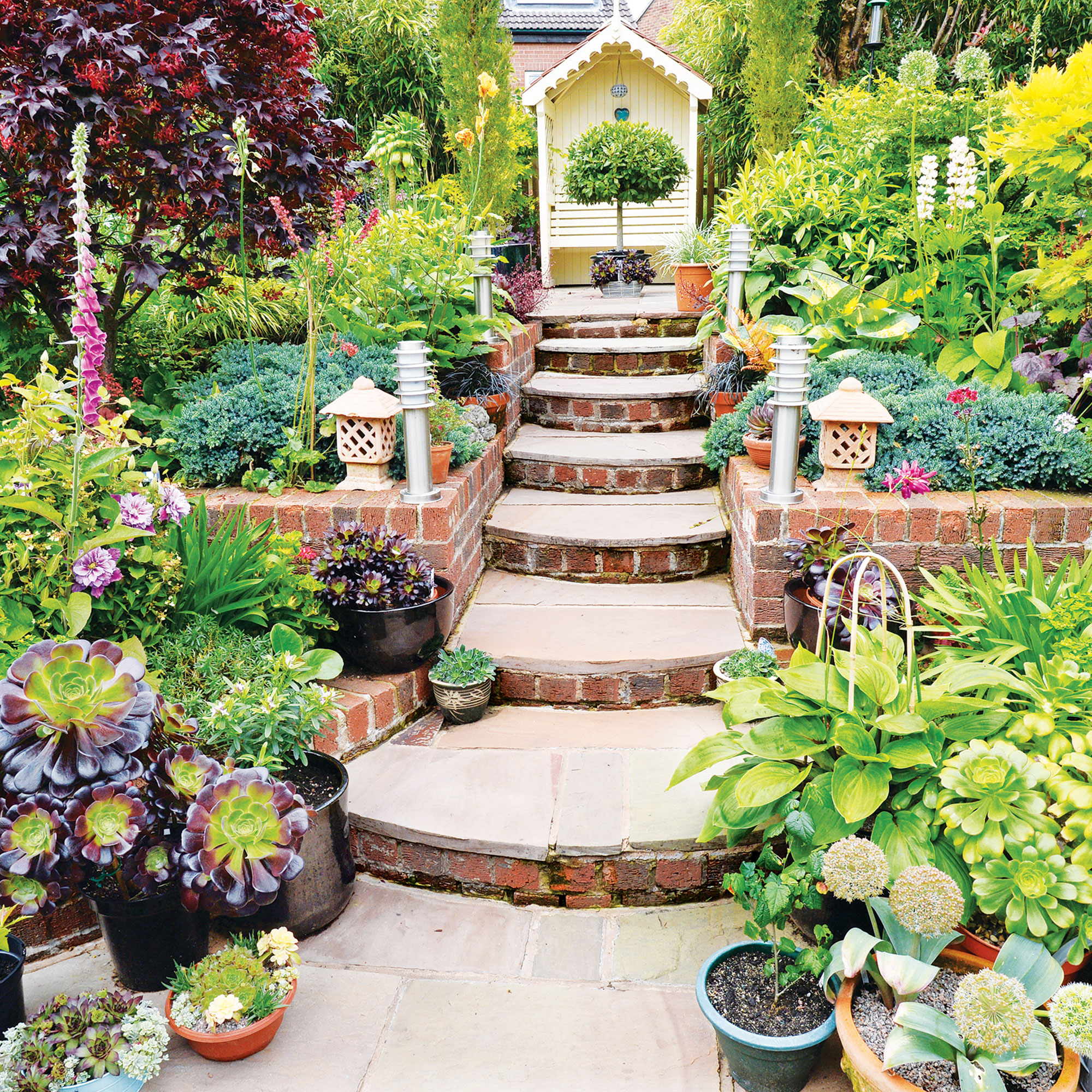
If you're thinking about how to plan a garden, remember that steps and raised beds are each ideal for sloping garden ideas, so why not bring in both? Shallow beds and long, shallow steps means you can roughly have one step per bed, creating a lovely sense of symmetry. Using the same material on the risers as the sides of the beds will also help visually link the structures.
'Don’t be afraid to experiment,' advises Carlos from TotalLawn. 'Mix up the planting, add in splashes of colour and ornaments where you can.' Pockets of potted plants will help create a real impression of cohesion.
2. Add flowerbeds between platforms and lawn
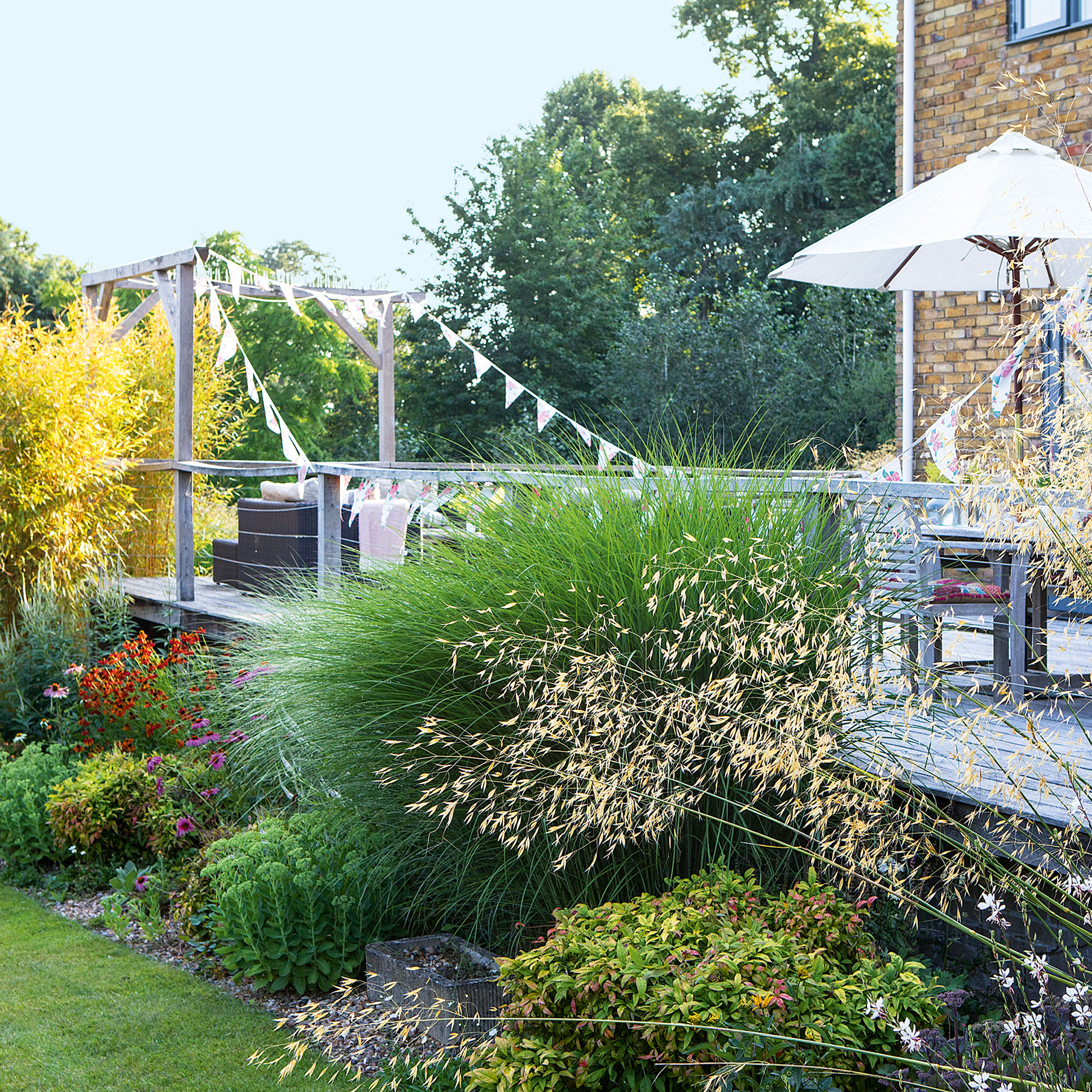
If there's a gap between your home and your sloping garden, a natural addition is a decked platform area for alfresco entertaining. This can, however, leave an awkwardly empty gap beneath. Fill this will lush planting to disguise.
If you want to keep the illusion that things are level, plant flowers and foliage which grow taller where there's the biggest height discrepancy between lawn and garden decking ideas.
3. Cut a path between sloping lawns
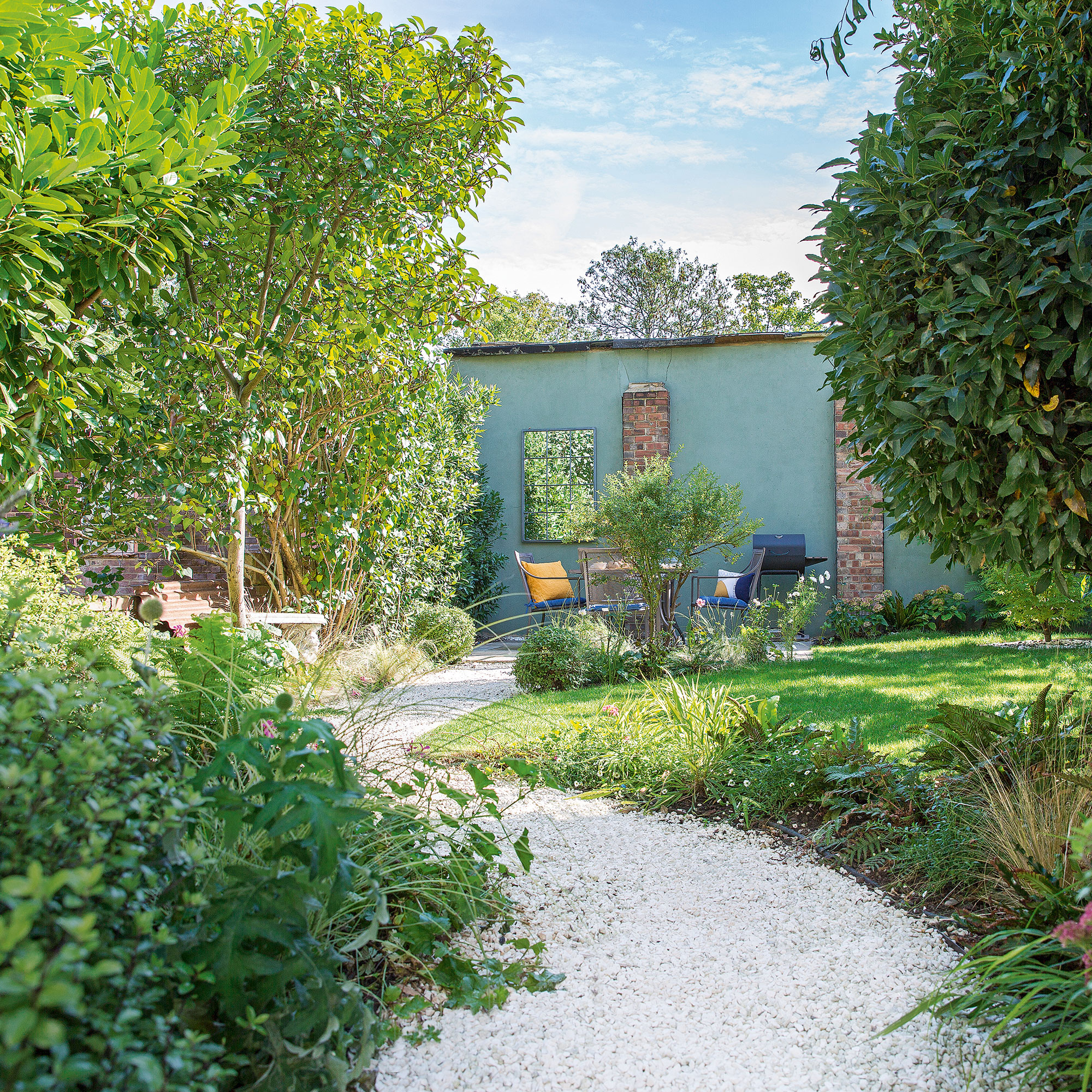
If your garden is only gently sloped and you're not dealing with a dramatic incline, then you have several options. Cutting a path to lay flat on the ground is ideal and a great use of easy garden ideas. This means you can get evenly from one end to the other, and easily plant a path border if desired.
Plus the look of the two sections of lawn gently sloping upwards gives a bucolic and calming impression.
4. Level out with a raised path
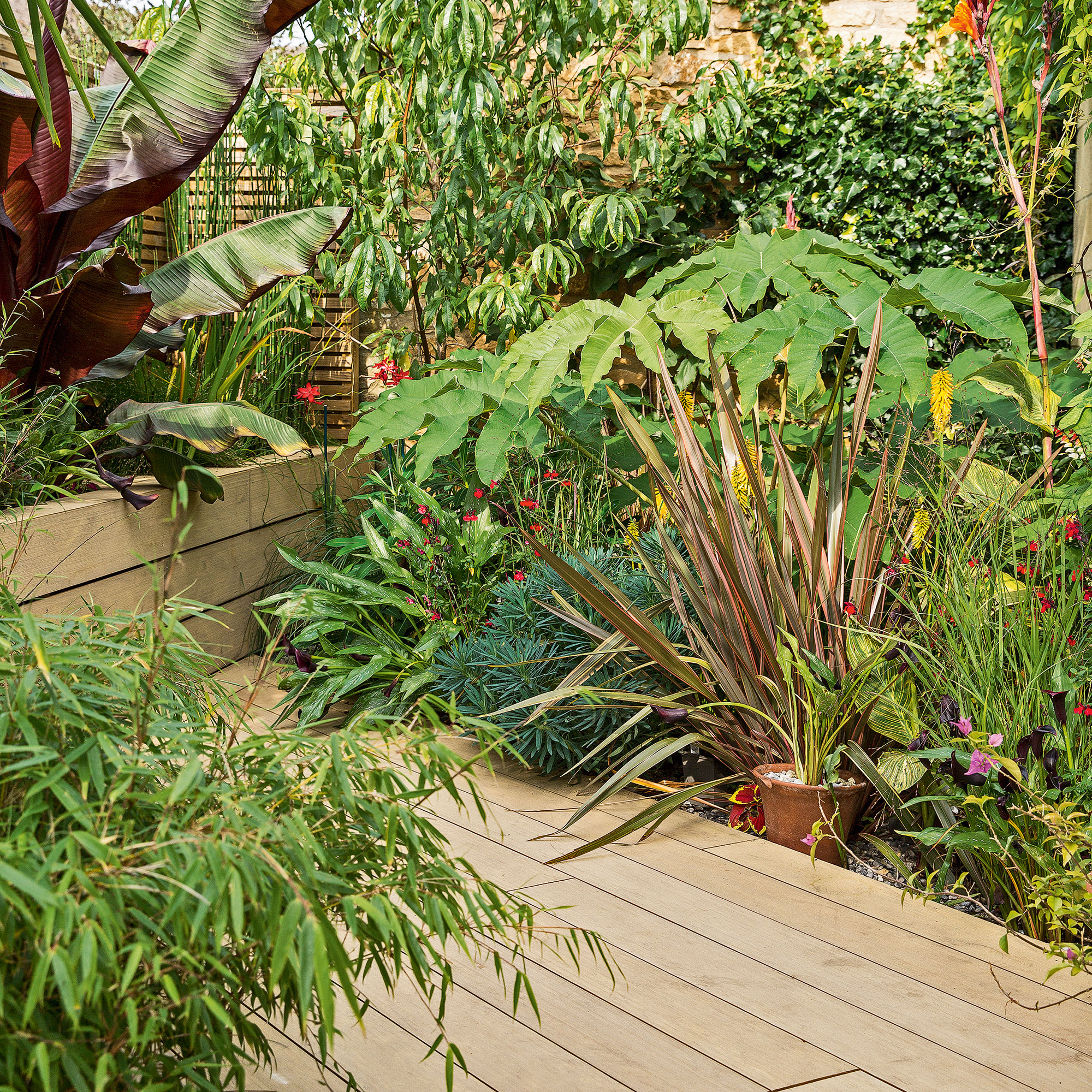
'Terracing can be time consuming and expensive, so consider all your options first,' advises Carlos from TotalLawn. 'For example, is there anything you can create yourself?'
One such DIY-possible creation is by building in a raised pathway. You can plant on the sloping areas and build a straight path running across the whole area. For safety reasons this is best if there's only a minor slope. Otherwise, it's worth adding a rail to prevent anyone from falling off.
5. Create a rockery inspired cottage garden
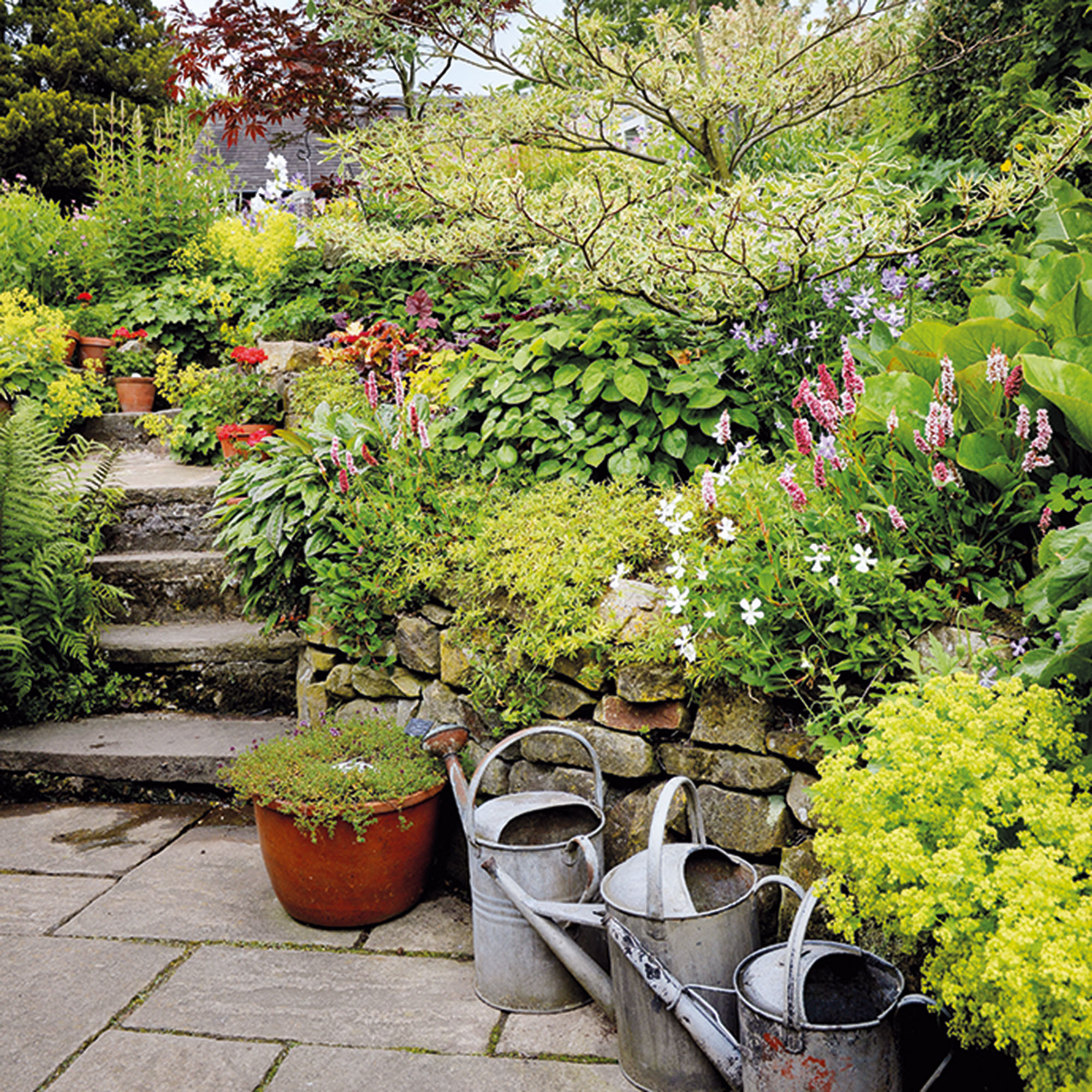
Cottage garden ideas are, by their very nature, more rustic and ad hoc in appearance. Use this approach to build in slightly wonky, quirky stone steps, walls and beds. You can go uneven in heights and levels and the effect with be charming rather than messy. Work in cottage garden planting to finish the look.
6. Soften a steep slope with grass steps
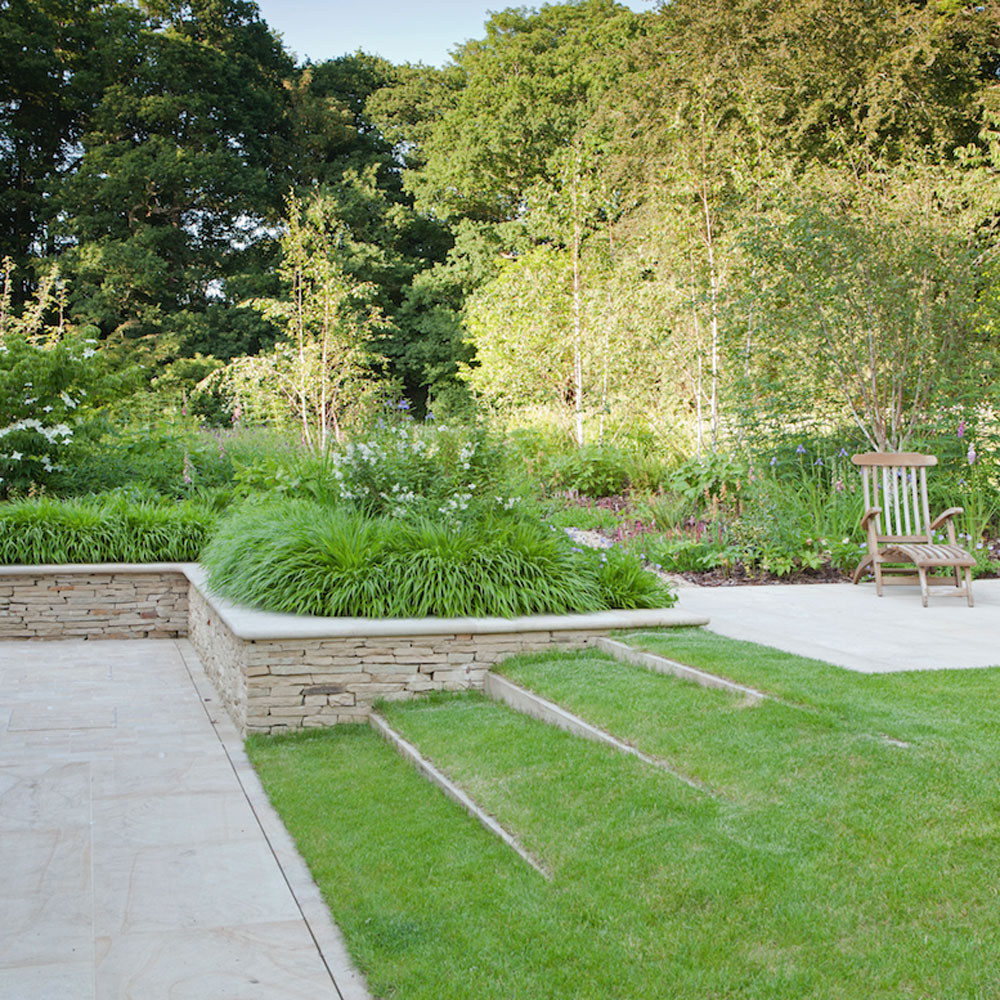
If your garden is on different levels and you're not keen on hard landscaping ideas take inspiration from this garden by Helen Elks-Smith MSGD, of Elks Smith Landscape & Garden Design. Instead of incorporating stone steps, Helen has used grass treads – integrating them into the existing lawn to connect the lower patio to the small sun terrace above. Creating a softer approach to the flow of the garden, seamlessly journeying from one space to the other.
The thoughtful addition of grass steps in this garden helps to make the sloped transition feel less structured, because too much paving can feel overwhelming for some settings. This idea is ideal if you want to join two paved areas without having to jeopardise any further lawn coverage.
7. Raise a seating area
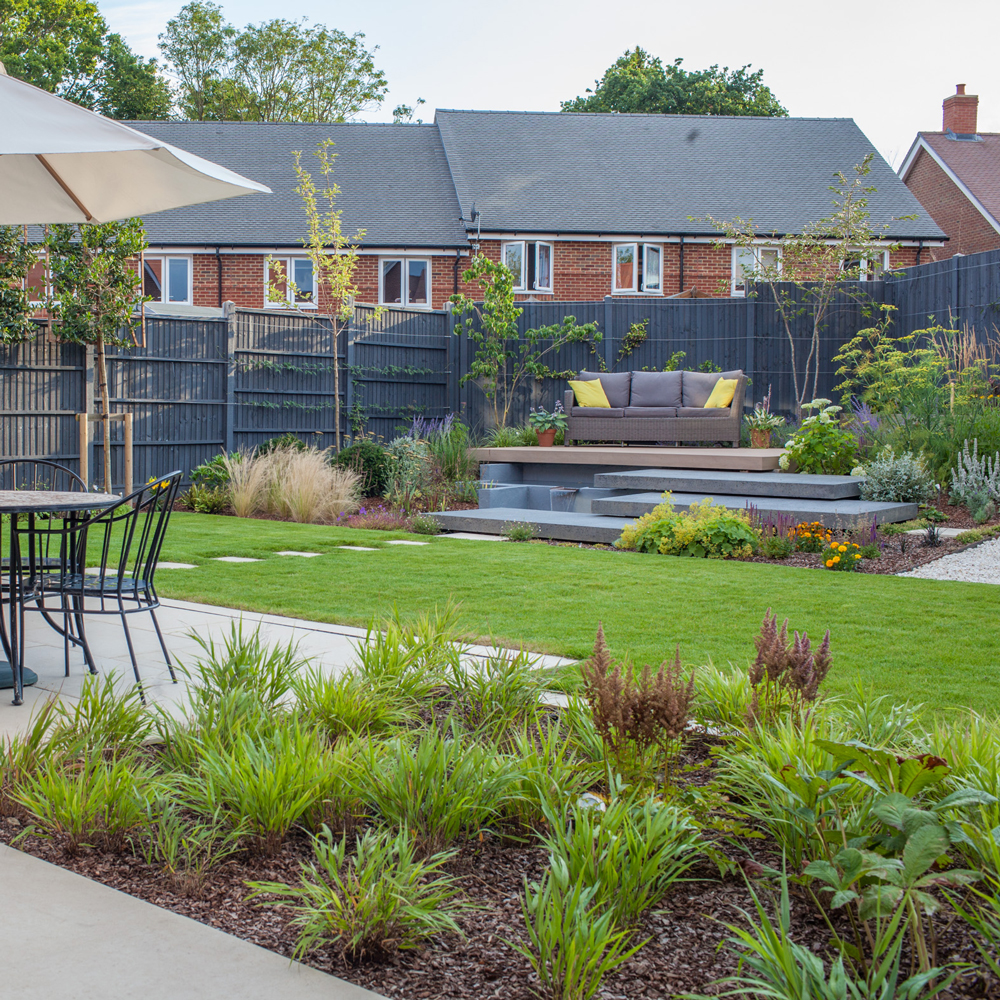
This new build property comprises of a garden that gently slopes up in two directions into the far corner. Garden designer Simon Orchard explains how he made the slope a design feature rather than a design feat.
'Levelling the whole garden would have been very expensive in terms of creating the retaining walls along the boundaries – and the walls would have been very high. So instead we only levelled the main terrace and lawn area then worked with the natural slope, incorporating the three chunky overlapping concrete steps leading up to a slightly elevated seating area.'
The staged seating area gives an elevated view over the rest of the garden.
8. Transition levels with a slide
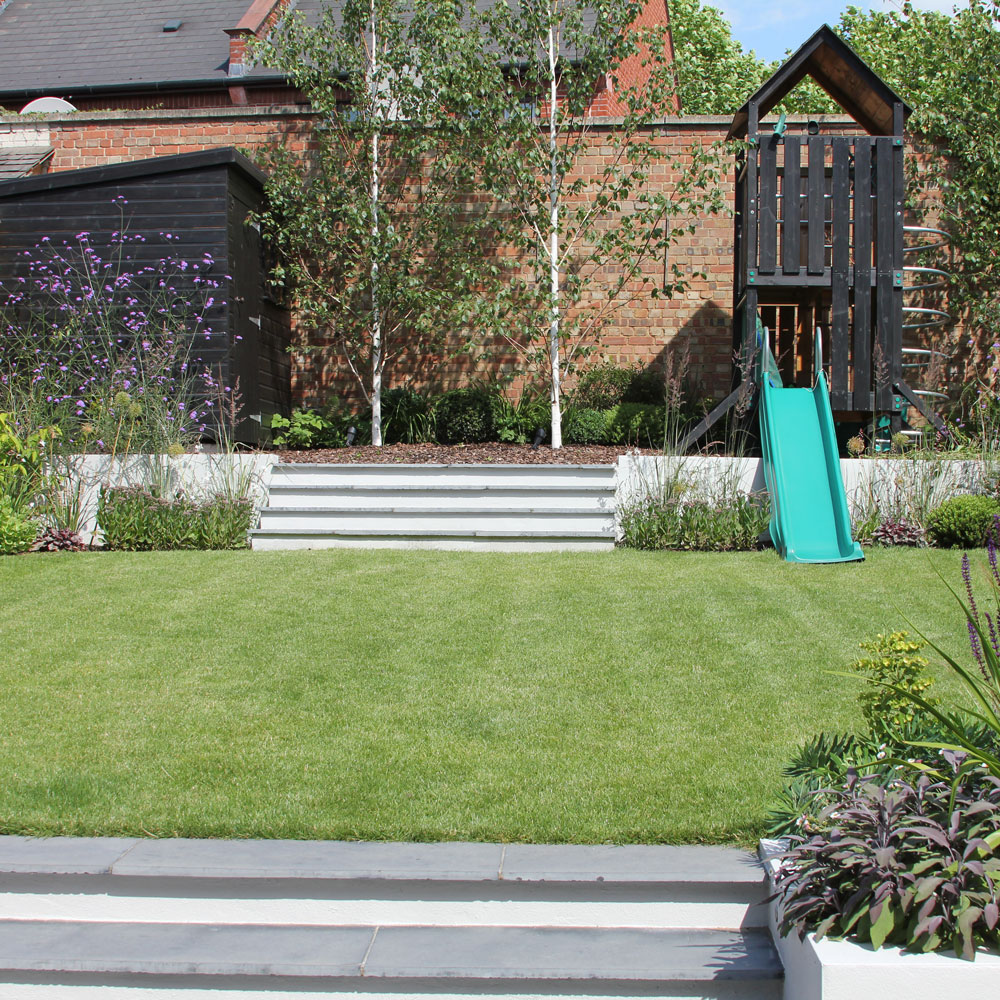
Garden designer Fiona Lamb has created a sloping garden of dreams for little ones, by connecting two levels with a garden play area complete with slide. The element of fun injects a different dimension to the beautifully landscaped garden. This brilliant budget garden idea is also highly practical, giving children a safe way to navigate the steeper levels.
9. Work with an incline to create a water feature
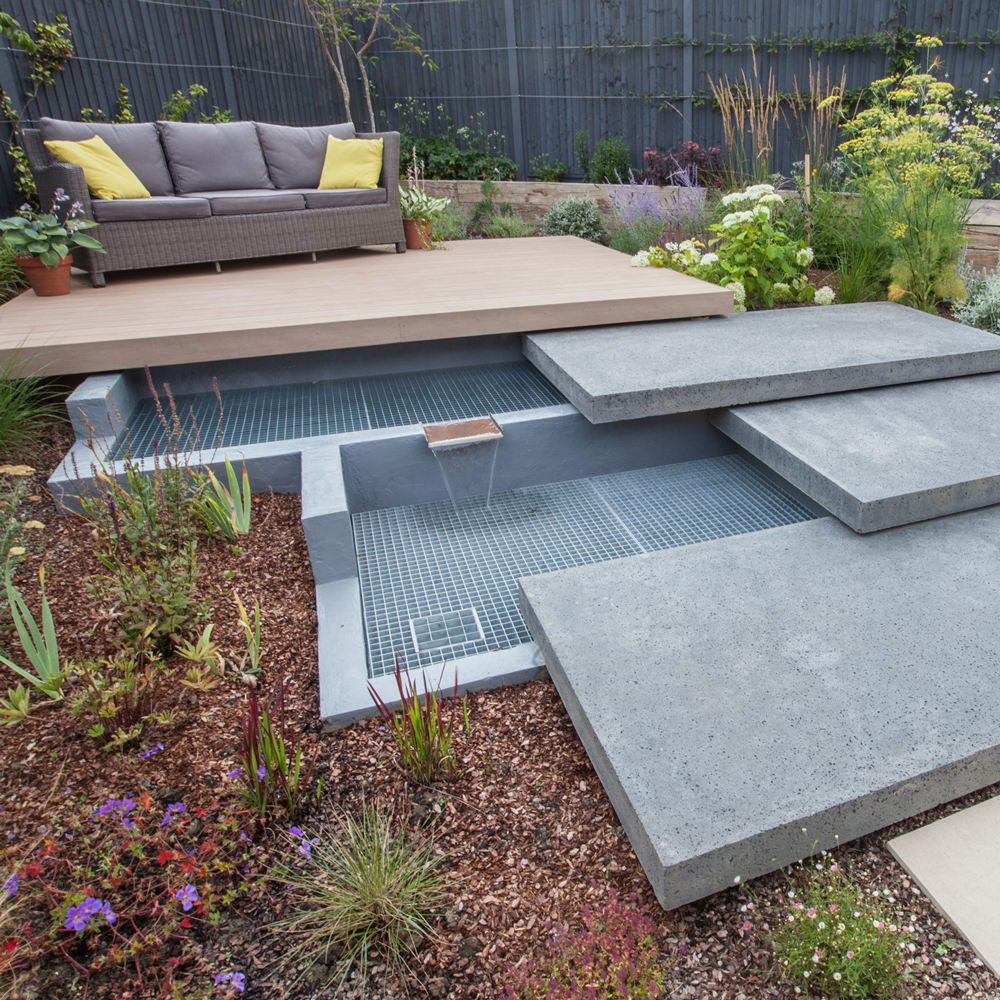
In the landscaped garden above, you'll see how Simon Orchard Garden Design used the uneven ground to naturally create drop water feature ideas.
'The grade of the slope was perfect for creating the bespoke two-level water feature,' says Simon Orchard. The different levelled groundwork lent itself perfectly to make a cascading water feature, a tranquil addition meaning the garden benefits from the sound of trickling water.
10. Take a different perspective on planting

'Sloping planting beds can be great to look at – rather than simply view a planting bed from the side an angled view creates a different perspective' says garden designer Helen Elks-Smith. Explaining how the planting differs, with flat beds,'you have to create planting schemes using plants that grow to different heights – but the same height plants will appear taller when looking up a slope.'
'And for some plants this different view has real impact,' advises Helen. 'For example looking into the top of a fern is very different to the view of the fronds from the side, roses and many flowering plants look equally good from the top.'
11. Enjoy a multi-level garden
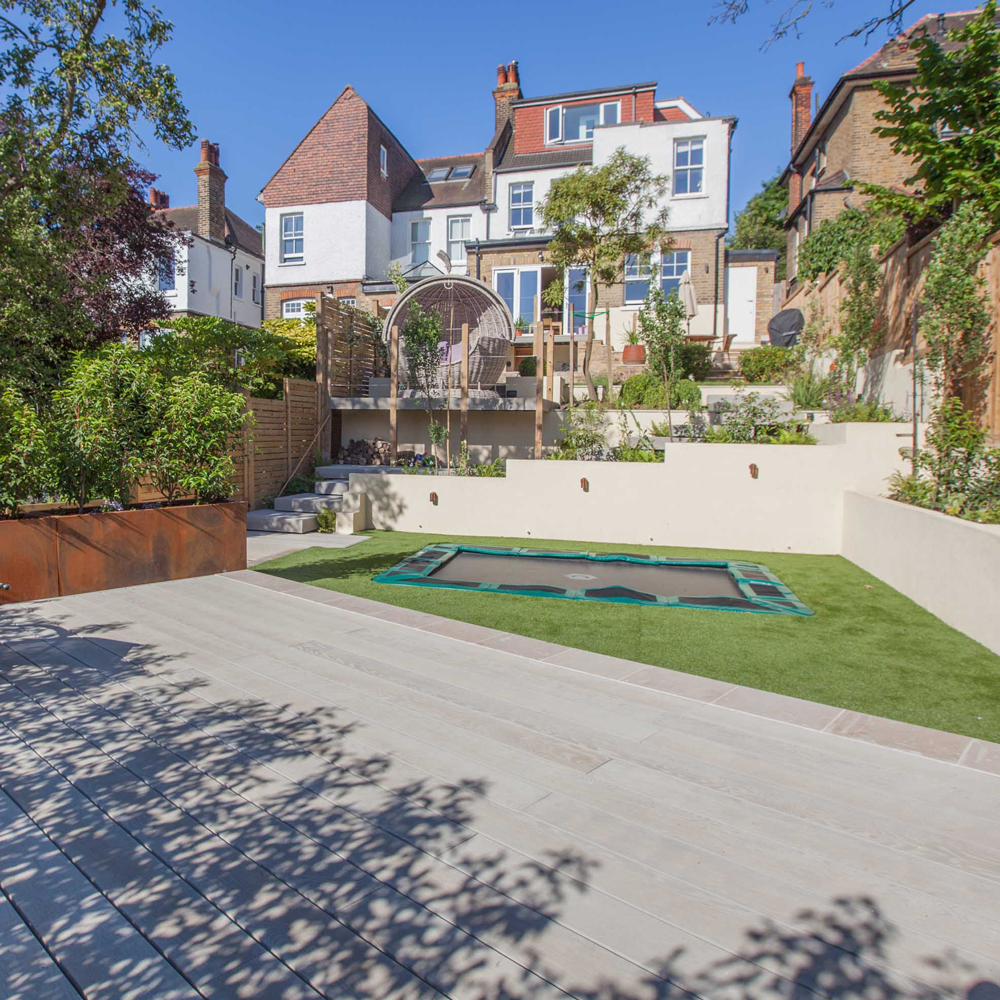
There's incline, and then there's ski slop-style that is hard to imagine where to start?! All you need is an expert, as this garden proves. 'This long sloped garden comprises a height difference of over 5 metres from the upper terrace to the bottom of the garden,' explains garden designer Simon Orchard. 'This made the space pretty much unusable.'
'The solution was to create a series of flat terraces, each serving a different purpose. With steps linking the different areas. A generous dining terrace was created at the upper level by the house, leading down to a lawn with flower borders and a secondary deck. This leads down to a sunken trampoline area from which you can walk onto the roof of the new studio/sauna - which was decked' Simon explains.
12. Zone with different levels
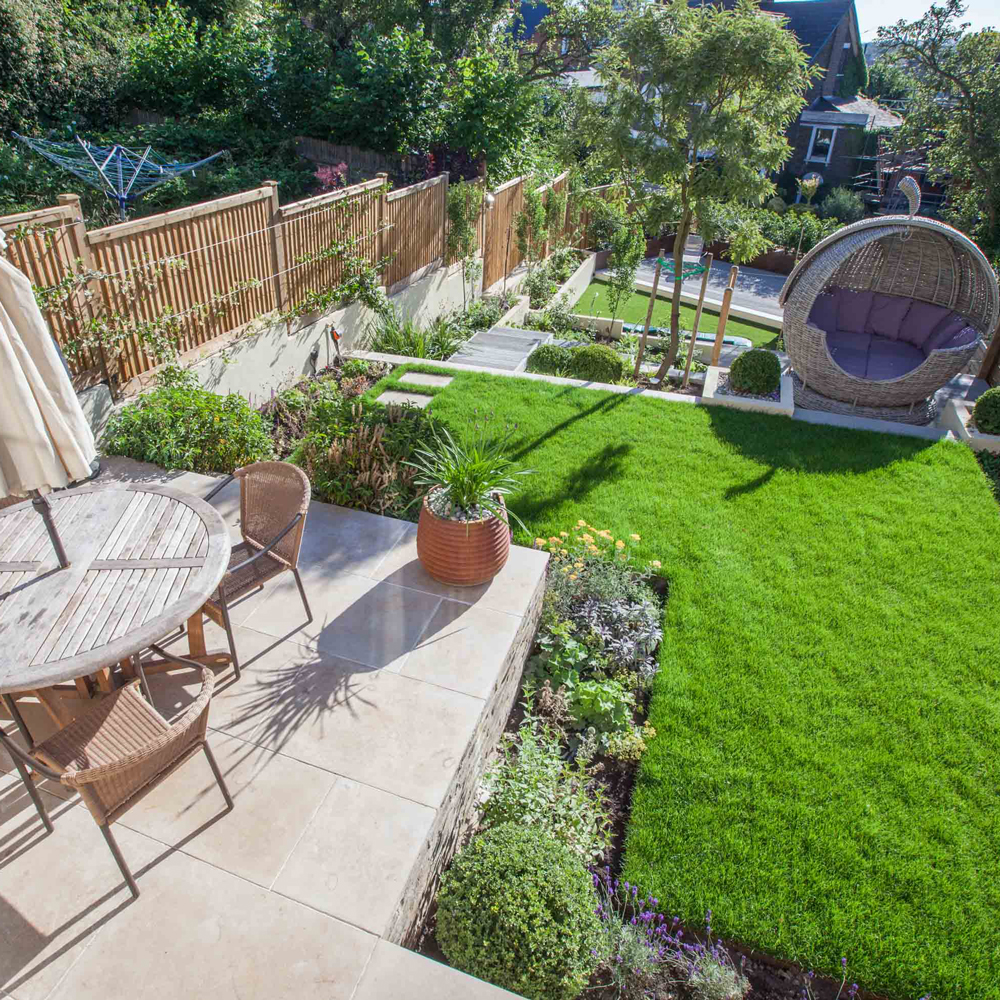
A steep sloping garden naturally invites the creation of clearly defined zones, each providing a different purpose. The result of creating a cascade of turfed terraces helps to shape an otherwise unusable garden into a multifunctional family space. Simon Orchard says, 'It's a much more usable garden with different areas to sit and relax in, enabling you to enjoy the garden at different times of the day and take in the various views.'
Garden landscaping costs explained, so you can determine just how much to pay for garden landscaping.
13. Use railway sleepers to add structure
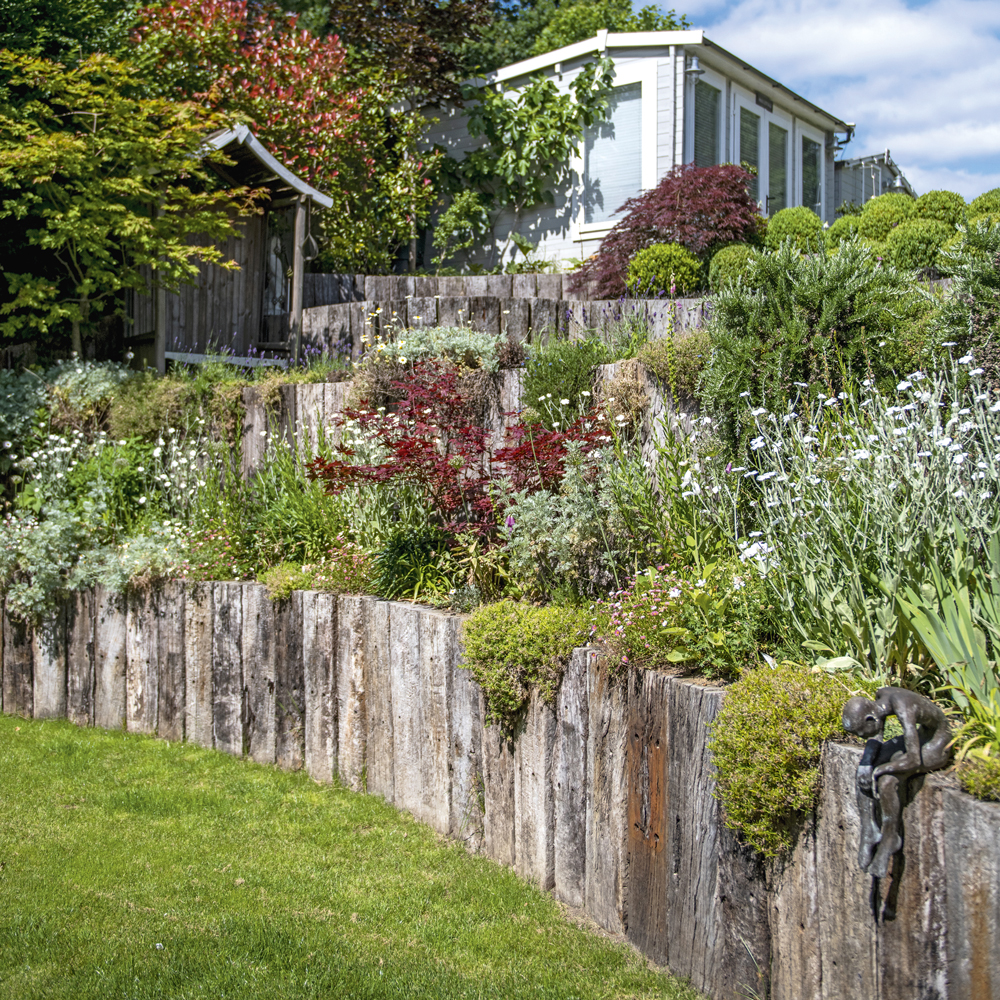
This New England style garden makes a feature of the different height levels, embracing it rather than try to soften the look. Low railway sleeper walls are used to contain flowerbeds between the descending levels.
If you choose raised borders planted with hardy perennials, such as hosta and astilbe, they won't need much care or constant maintenance. Add splashes of colour with drought-resistant osteospermum and gazania.
14. Install a pond to split different levels
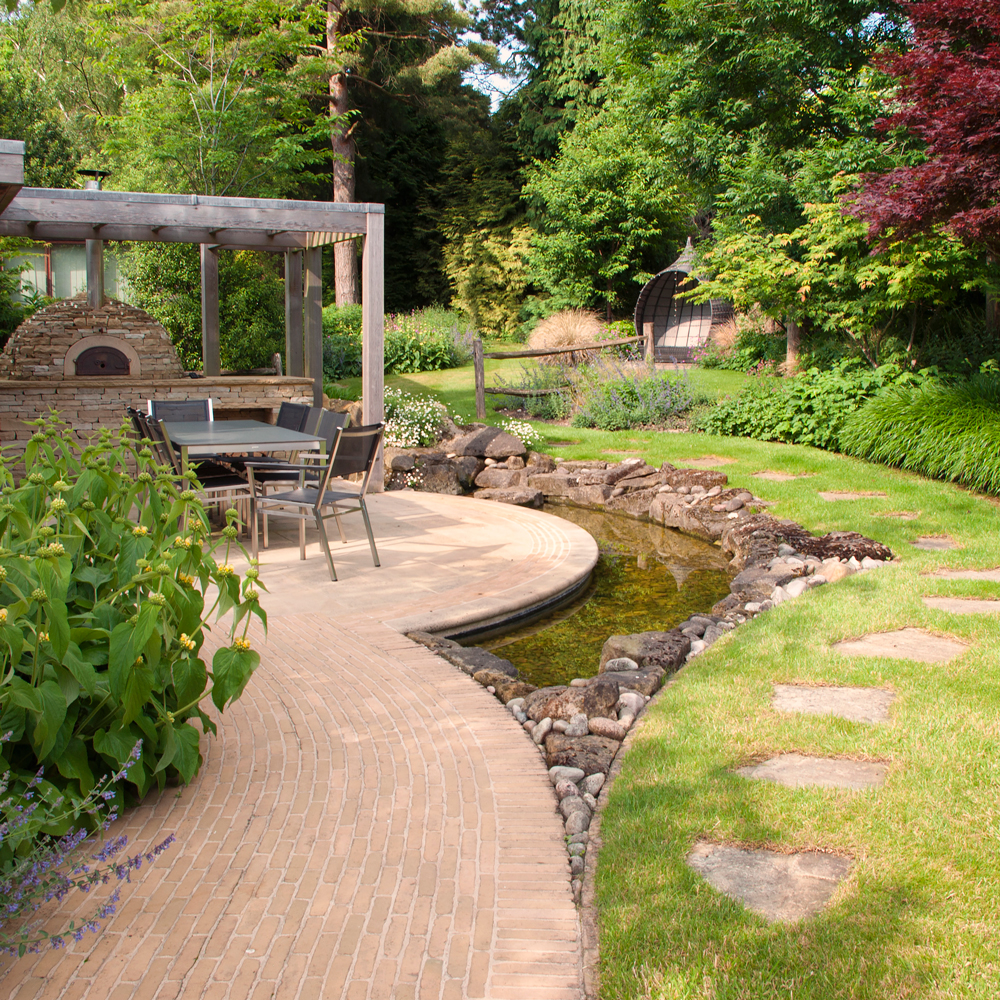
This thoughtful example shows how a hardscape stone wall on the side of a pond was used to deal with a slope across a garden. The wall helps to disguise the slope by making the stone framing look intentional to elevate the lawn beyond. A pond is also a fabulous wildlife garden idea, to turn your outdoor space into a haven for wildlife.
15. Make a statement with lighting
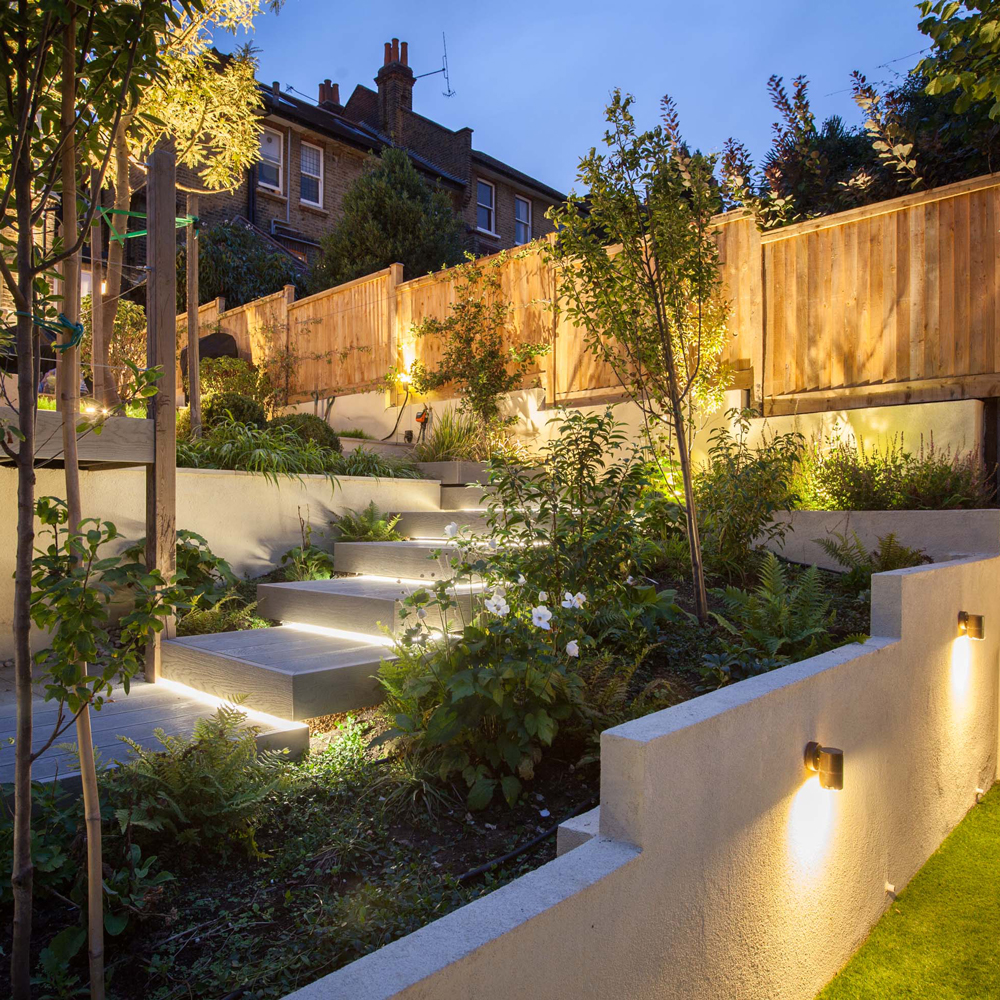
The different levels of a sloping garden provides the ideal layout to use garden lighting ideas to full effect. On a practical note it accentuates the different heights between levels, providing a safer way to navigate the journey through. In terms of design the lights add a more dramatic look, as they highlight key planting and bring the many zones to life with illumination.
Try setting each zone to a different light level to ensure you can provide the right light for each setting – brighter in the kids' area, more ambient on a terrace made for entertaining.
16. Give steps character with gabion walls
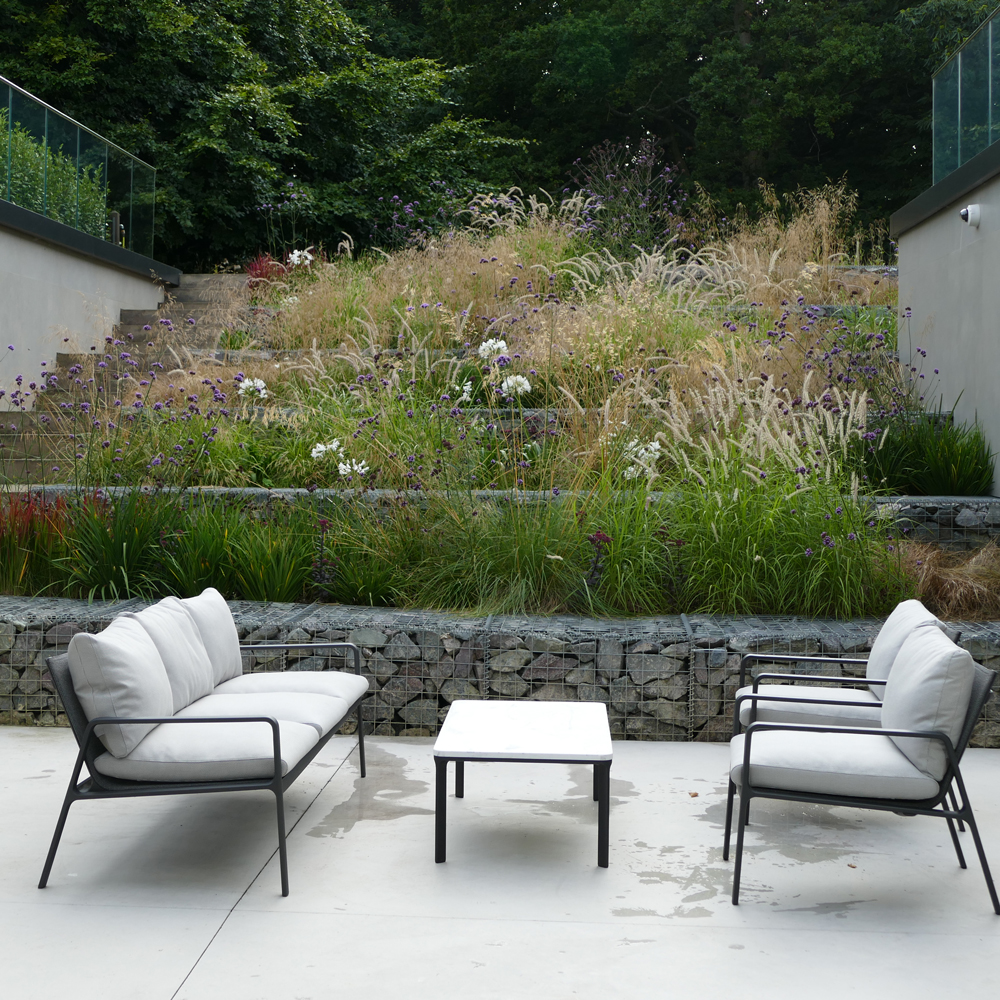
'We designed the expansive landscape surrounding this modern architectural property, including this terraced garden leading away from the house and its adjoining terrace' explains John Wyer, CEO and lead garden designer at Bowles & Wyer.
'We’ve paired sleek paving with gabion-structure walls to create the terraces, finished with naturalistic and textural planting with splashes of Verbena. Not only does it provide an interesting journey as you travel up the steps to the main garden, but it creates a beautiful vista from the house too.
17. Structure a terraced garden
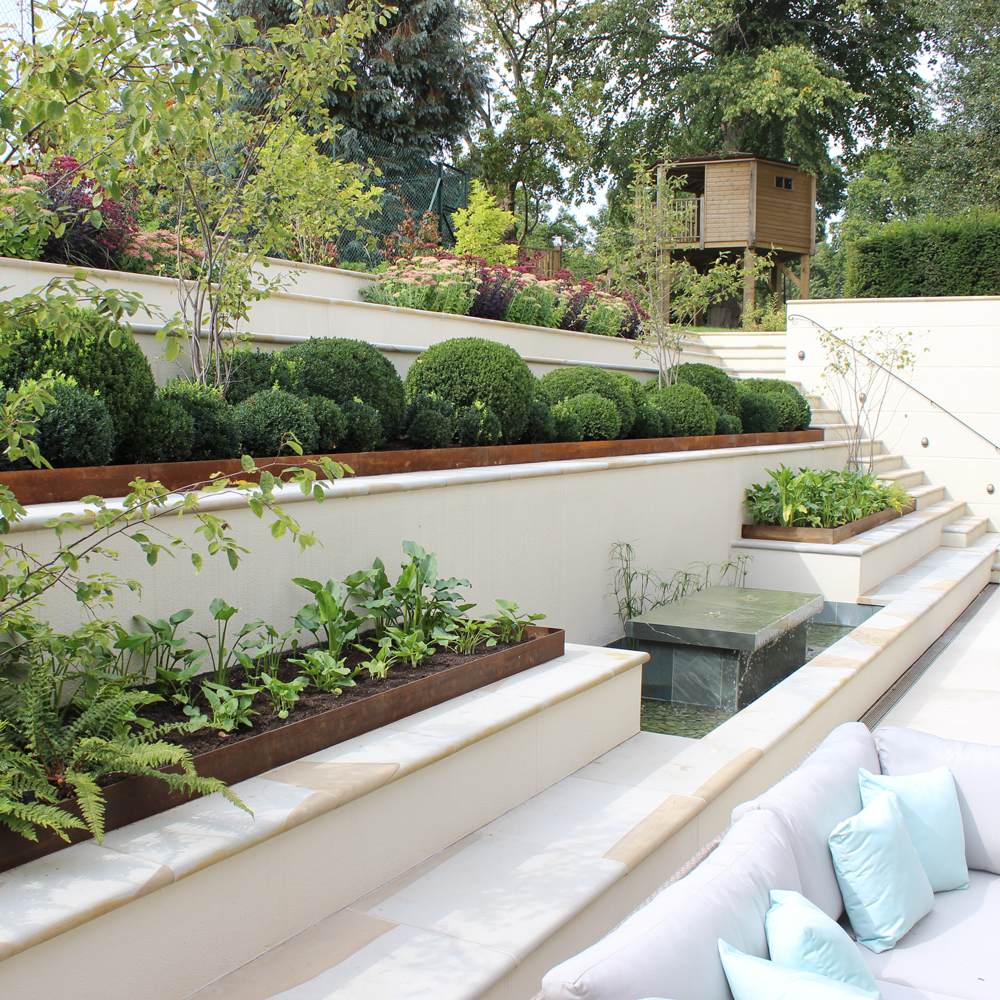
'This was a large country garden we designed and built in Berkshire,' explains John Wyer. 'We used the sloping land leading to the property to create a modern terraced garden, which provides an outlook of greenery from every facing window in the house. The lighting scheme also ensures this terraced space is the perfect spot for evening entertaining.'
This design could be scaled down to suit a small garden idea to give the space more purpose and a clearly defined structure. Work with a landscape gardener to tailor the space to suit your own garden needs.
18. Gently transition between levels
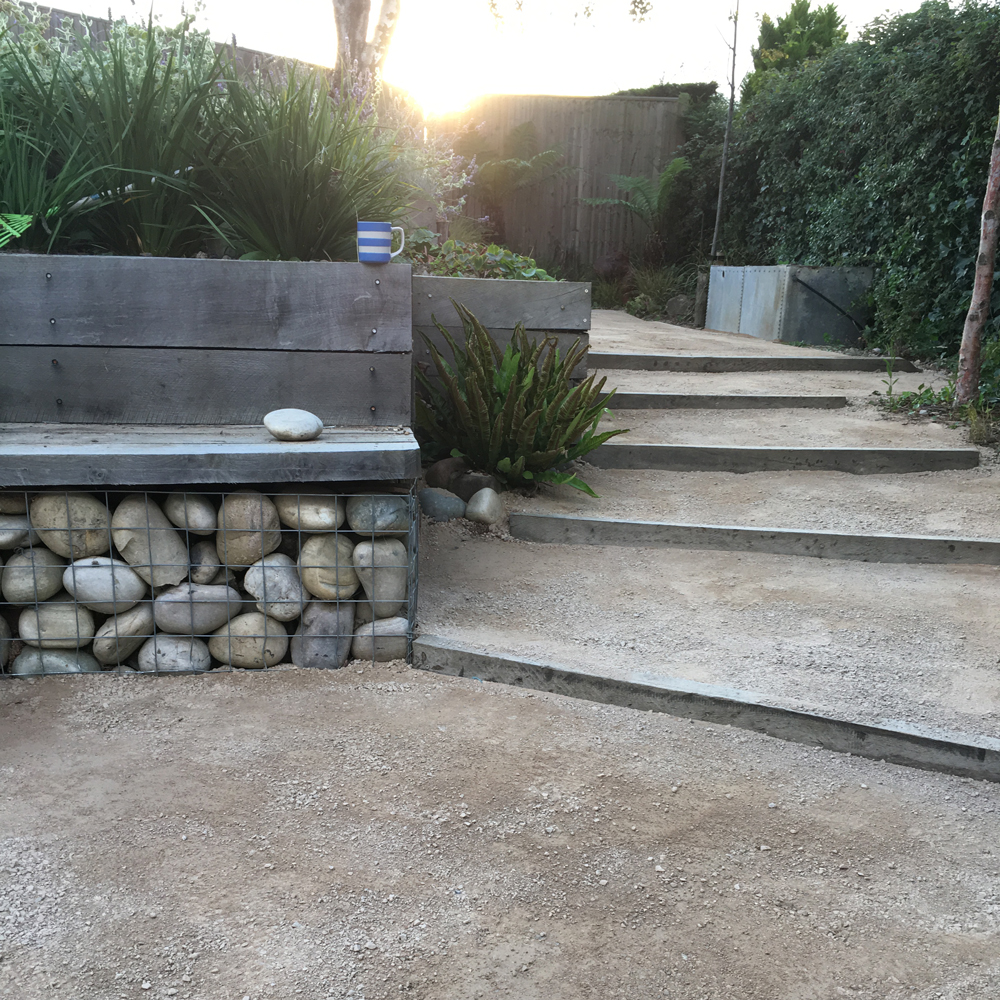
'Combine retaining walls with slowly rising steps, which encircle the sloping ground to subtly transition the levels' suggests landscape designer Marcus Foster, 'providing a design feature in the process. His idea to do so is, 'Using natural materials such as breedon gravel and gabion cages.'
'With over-sized aggregates the level changes can be further softened to slow down the pace and thought of moving through the space.'
How do you landscape a slope on a budget?
Embracing it as much as you can, will save costs because your budget isn't eaten up by levelling the ground. Landscaping a slop on a budget is possible by decking over the top of the old surface and swapping raised planters for pots.
'Think about how you use your garden,' advises Carlos Real, Managing Director, TotalLawn, on how to landscape on a budget. 'Do you want a seating area, an area to grow veg, or just an aesthetically pleasing lawn? Separate your space through functionality but think practically about transitioning from one area to the next. Separate your space by introducing rows of flower beds, using railway sleepers to build retaining walls or building fencing using wooden pallets and paint to add a splash of colour.'
'Create a defined route,' continues Carlos. 'Consider how you are moving from one section to another. Whether you require steps or not depends entirely on how much your garden slopes. Why not add in stone slabs? They don’t cost a lot; you may even find some lying around or on Facebook Marketplace for free! Just make sure they’re securely in position (for safety purposes, of course).'
'It’s important to have a space where you can kick back and relax in the summer months. Bark chippings or gravel are quick and inexpensive ways to create a reasonably-level seating area – and can be tailored entirely to the aesthetic you are trying to achieve; gravel and slate in particular come in a range of colours which can be used to break up spaces in the garden.'
'Maintaining a lawn on a slope can be difficult, and even dangerous when operating machinery,' adds Carlos. 'For the most sloped areas, prioritise planting flower beds and keep your lawn in the flatter areas of your garden, where possible.'
What can I do with a sloping garden?
A sloping garden naturally provides different levels to create different zones - one for dining; one for kids; a level for a garden room or a vegetable plot. Zoning the garden allows the space to provide a multifunctional purpose.
'Water run off from any sloping ground will need to be considered,' warns garden designer Helen Elks-Smith. 'Especially where the ground slopes back to the property and out from a driveway. In both cases drainage needs to be considered to capture the water and deal with on site.'
'Sometimes you need or want to cut into a slope, to form terraces. This does tend to push up budgets as the soil then needs to be retained. Drainage is always needed behind garden walls and the walls themselves need to be specially constructed to retain the soil or structures, structural engineers can help. And moving between the different heights often needs steps. But sloping paths can work just as well and will make the space accessible for all.'
Put down a weed-suppressing membrane (from garden centres) to cut down on the amount of weeding. Then plant the border with ground cover plants, such as geraniums or catmint. Geraniums, in particular, provide good ground cover and colour through the summer. Use tall pots planted with grasses for a statement display.
Can you flatten a sloped garden?
Depending on the height of the slope it may be possible to flatten, but it involves a lot of work and a hefty budget. Levelling a garden can be expensive and might not give you the garden you desire. So working with a garden landscaper to design a garden that embraces the unconventional layout might be a better option.
Tamara was Ideal Home's Digital Editor before joining the Woman & Home team in 2022. She has spent the last 15 years working with the style teams at Country Homes & Interiors and Ideal Home, both now at Future PLC. It’s with these award wining interiors teams that she's honed her skills and passion for shopping, styling and writing. Tamara is always ahead of the curve when it comes to interiors trends – and is great at seeking out designer dupes on the high street.
-
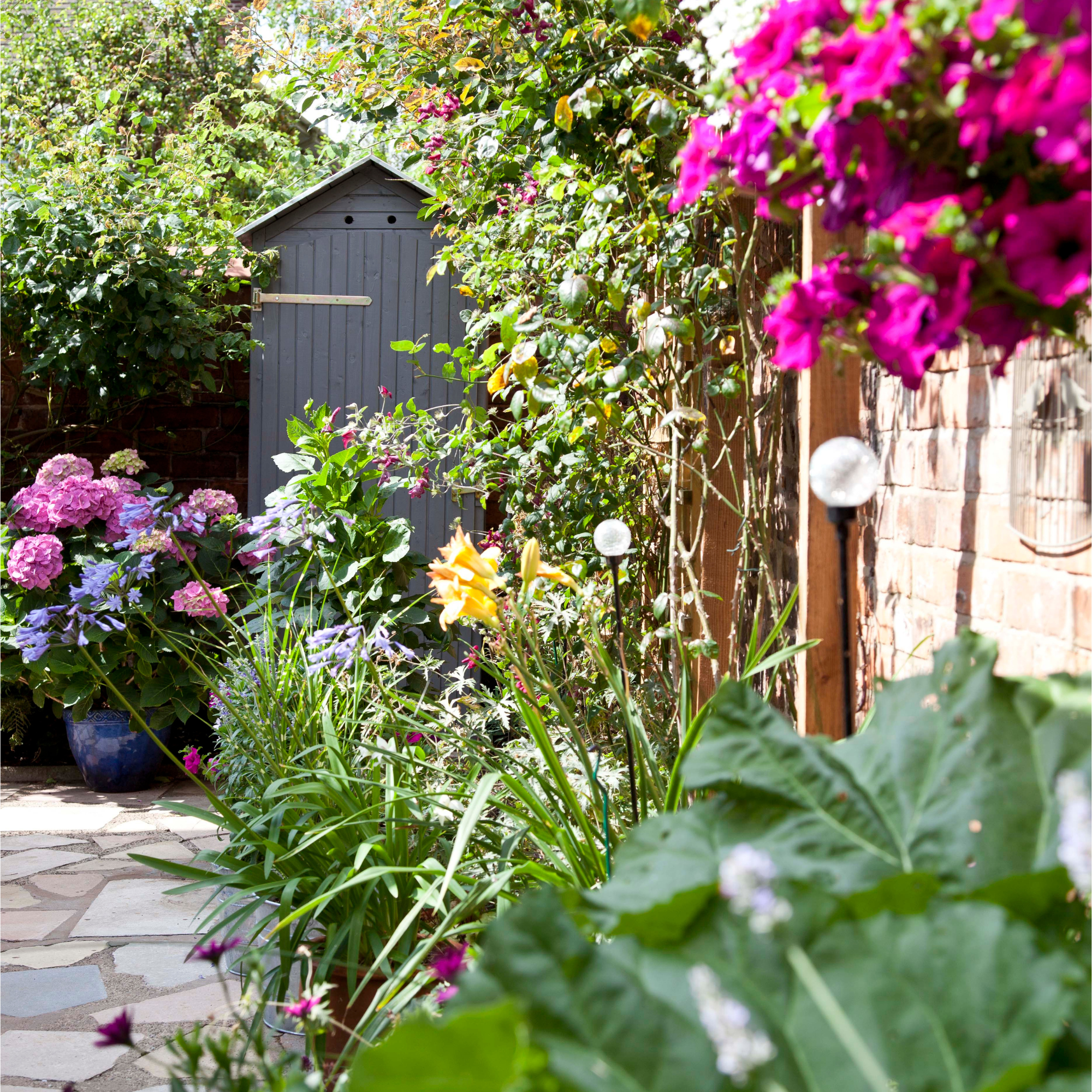 Small garden shed ideas – 5 ways to make the most of this garden building without compromising on space
Small garden shed ideas – 5 ways to make the most of this garden building without compromising on spaceThere's a shed for every garden size – even the tiniest ones!
By Sophie King
-
 My mum introduced me to Nancy Birtwhistle’s ‘Pure Magic’ recipe - now I don’t think I’ll need to buy another cleaning product ever again
My mum introduced me to Nancy Birtwhistle’s ‘Pure Magic’ recipe - now I don’t think I’ll need to buy another cleaning product ever againI live in a hard water area, and it's the ONLY thing that's removed the limescale in my toilet
By Lauren Bradbury
-
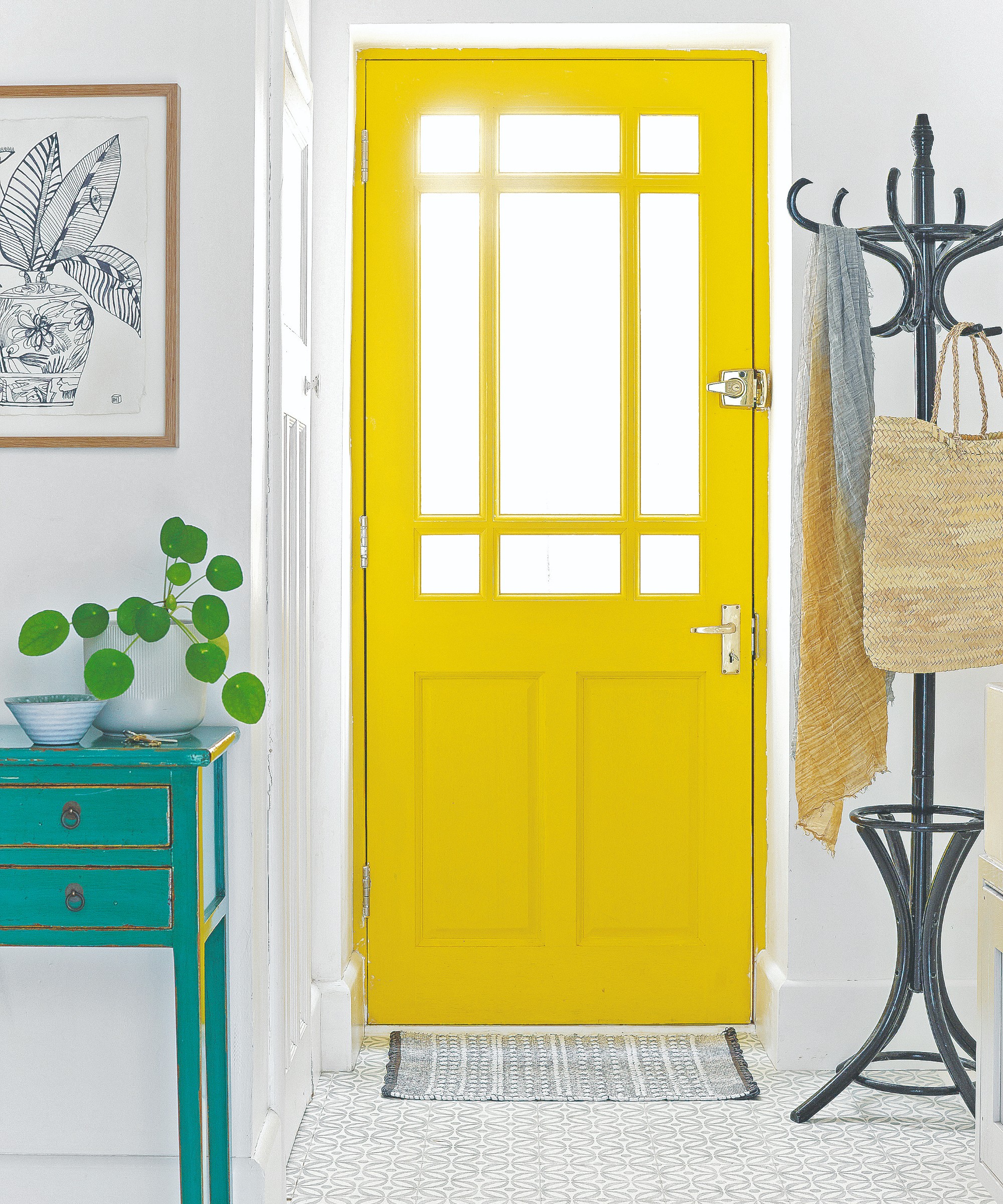 5 most welcoming colours to paint a front door, according to experts and colour psychology
5 most welcoming colours to paint a front door, according to experts and colour psychologySend out the welcoming vibes before the door is even open
By Ellis Cochrane